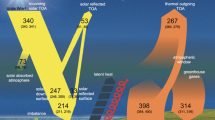Abstract
The results ofthe joint analysis ofthe data ofinstrumental observations using LS8000 lightning detector, weather radars (MRL-5 and DMRL-C), and electric field strength sensors as well as the results of numerical simulation of electric parameters of developed convective clouds based on the three-dimensional model worked out at High-mountain Geophysical Institute are presented. Some results of mathematical modeling of electric charges and fields in a convective cloud in the process of its evolution are described. The computations are based on the real data of atmospheric upper-air sounding on the days with thunderstorm and hailstorm processes in the North Caucasus. The effects of electric processes on the formation of micro structural parameters of convective clouds and precipitation are studied.
Similar content being viewed by others
References
A. Kh. Adzhiev and E. M. Bogachenko, Thunderstorms in the North Caucasus (Poligrafservis i T, Nalchik, 2011) [in Russian].
A. Kh. Adzhiev, D. D. Kuliev, A. M. Abshaev, et al., "Hardware-software Complex of Electric Field Strength Monitoring in the Atmospheric Surface Layer," Izv. KBNTs RAN, No. 2 (2013) [in Russian].
A. Kh. Adzhiev and S. T. Tamazov, "Separation of Electrical Charges during Crystallization of Water Droplets," Meteorol. Gidrol., No. 8 (1987) [Sov. Meteorol. Hydrol., No. 8 (1987)].
A. Kh. Adzhiev, V. N. Stasenko, and V. O. Tapaskhanov, "Lightning Detection System in the North Caucasus," Meteorol. Gidrol., No. 1 (2013) [Russ. Meteorol. Hydrol., No. 1, 38 (2013)].
A. A. Adzhieva, V. A. Shapovalov, I. Kh. Mashukov, et al., "Detection and Identification of Hazardous Convective Processes by Radio Aids," Izv. Vysshikh Uchebnykh Zavedenii. Severo-Kavkazskii Region. Estestvennye Nauki, No. 1 (2014) [in Russian].
B. A. Ashabokov, L. M. Fedchenko, A. V. Shapovalov, et al., "Numerical Experiments on Studying the Formation of Microstructural Parameters of Thunderstorm and Hailstorm Clouds," Izv. Vysshikh Uchebnykh Zavedenii. Severo-Kavkazskii Region. Estestvennye Nauki, No. 3 (2014) [in Russian].
B. A. Ashabokov and A. V. Shapovalov, Convective Clouds: Numerical Models and Simulation Results under Natural Conditions and Cloud Seeding (KBNTs RAN, Nalchik, 2008) [in Russian].
I. M. Imyanitov and E. V. Chubarina, Electricity in the Free Atmosphere (Gidrometeoizdat, Leningrad, 1965) [in Russian].
I. M. Imyanitov and N. S. Shifrin, "State-of-the-art of Atmospheric Electricity Research," Uspekhi Fizicheskikh Nauk, No. 4, 76 (1962) [in Russian].
E. L. Kogan, I. P. Mazin, B. N. Sergeev, and V. I. Khvorost’yanov, Numerical Modeling of Clouds (Gidrometeoizdat, Moscow, 1984) [in Russian].
V. N. Morozov, N. E. Veremei, and Yu. A. Dovgalyuk, "Modeling Electrization Processes in a Three-dimensional Numerical Model of Precipitation-generating Cloud," Trudy GGO, No. 559 (2009) [in Russian].
A. V. Shapovalov and V. A. Shapovalov, "Three-dimensional Visualization of Geophysical Information for Solving Applied Problems," Nauka. Innovatsii. Tekhnologii, No. 1 (2014) [in Russian].
K. A. Browning and G. B. Foote, "Airflow and Hail Growth in Supercell Storms and Some Implications for Hail Suppression," Quart. J. Roy. Meteorol. Soc., 102 (1976).
R. D. Farley and H. D. Orville, "Numerical Modeling of Hailstorms and Hailstone Growth. Part I. Prelimmary Model Verification and Sensitivity Tests," J. Clim. Appl. Meteorol., 25 (1986).
X. L. Guo and M. Y. Huang, "Hail Formation and Growth in a 3D Cloud Model with Hail-bin Microphysics," Atmos. Res., 63 (2002).
H. B. Xu, Y. Duan, and H. Y. Liu, The Physics of Hailstorm and the Principle and Design of Hail Suppression (Meteorology Press, Beijing, 2004).
Author information
Authors and Affiliations
Corresponding author
Additional information
Original Russian Text © A.Kh. Adzhiev, V.N. Stasenko, A.V. Shapovalov, V.A. Shapovalov, 2016, published in Meteorologiya i Gidrologiya, 2016, No. 3, pp. 46-54.
About this article
Cite this article
Adzhiev, A.K., Stasenko, V.N., Shapovalov, A.V. et al. Atmospheric electric field strength and thunderstorms in the North Caucasus. Russ. Meteorol. Hydrol. 41, 186–192 (2016). https://doi.org/10.3103/S1068373916030031
Received:
Published:
Issue Date:
DOI: https://doi.org/10.3103/S1068373916030031



